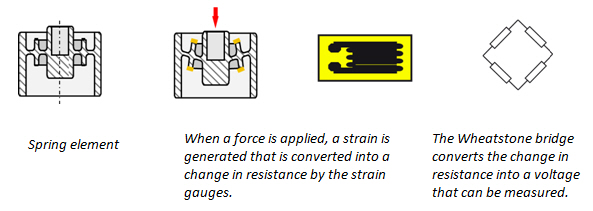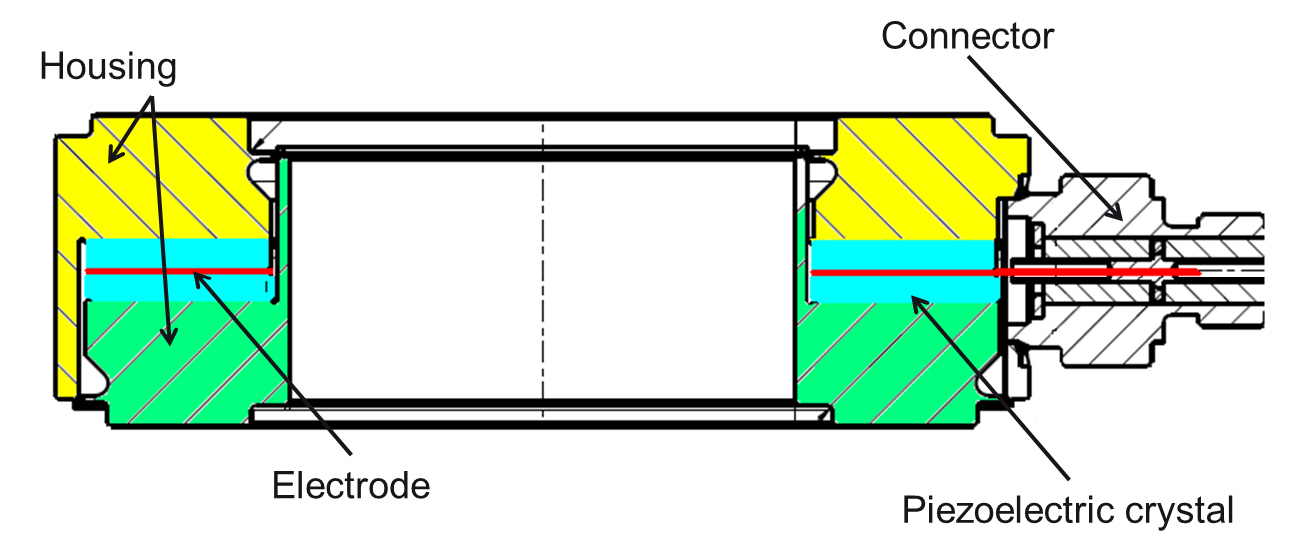Strain gauge based force transducers always comprise a spring element to which force is applied. This force results in minimal deformation of the spring element. Strain gauges installed at appropriate points are extended and therefore show a change in resistance. A minimum of four strain gauges are connected into a Wheatstone bridge circuit. When voltage is fed to this measuring bridge, the resulting output voltage is proportional to the applied force.
Piezoelectric or Strain Gauge Based Force Transducers?
Two principles have become dominant in force measurement: Piezoelectric sensors and strain gauge (SG) based force transducers. When is which principle appropriate?
1. Technical basics

Piezoelectric sensors comprise two crystal disks with an electrode foil mounted in between. When applying force, this results in an electrical charge that can be measured using a charge amplifier. The charge is proportional to the applied force.

2. Which sensor principle is suited for which application?
Static monitoring tasks
Strain gauge based sensors show almost no drift and are therefore particularly suited for long-term monitoring tasks. The so-called creep - the time-dependent, however, reversible change in output signal under a constantly applied force - is extremely small, since it can be minimized through careful selection of the strain gauge layout. Modern sensors from HBM, for example, S2M achieve creep values of less than 200 ppm related to the measured value - an error that is negligible in many applications.
Due to their principle of operation, piezoelectric force sensors have a drift - an estimated 1 N/min has to be expected when the measuring chain has been run in. Since this value remains unchanged, irrespective of the measured force, the relative measurement error resulting from the drift is particularly unfavorable when small forces are being measured over a long period of time.
Dynamic force measurements
Piezoelectric sensors show very small deformation when force is applied - they offer high stiffness. This results in a high resonance frequency, which, in principle, is very favorable in dynamic applications. However, the entire measuring chain is critical to the dynamic properties. Here, it is of significance that the mounting parts used to install the sensor have additional mass, which, of course, has an impact on the system's overall mass and thus on the cut-off frequency. Furthermore, many charge amplifiers have a bandwidth that depends on the charge and thus on the force that is measured. Large forces result in high electrical charges which in turn limits the bandwidth.
Strain gauge based systems achieve higher cut-off frequencies whenever transducers with larger nominal (rated) forces are used. In principle, force transducers for small forces are soft spring elements - the transducers' resonance frequency is correspondingly low. It is essential to refer to the data sheet in each case, however: Piezoelectric sensors are first choice for fast measurements of small forces while strain gauge based force transducers often are superior when large forces are involved.
Calibration tasks
The circuit used for connecting the strain gauges enables many error effects to be compensated for. In addition to the temperature effects on the zero point and sensitivity this includes the linearity of transducers or the effect of the bending moment. Furthermore, strain gauge sensors allow very precise static calibration. Spring elements can moreover be designed to achieve optimal reproducibility. As a result, strain gauge based force transducers exclusively are used in the field of reference force measurement.
High initial load
When force is applied, piezoelectric sensors produce an electrical charge that can be short-circuited, if required. The status of the charge amplifier input then equals the status at 'zero' force. As a result, the charge amplifier's input range is not affected even by high initial loads. Piezoelectric transducer technology therefore allows measurements at maximum resolution even in unfavorable conditions.
In tough environments
Some strain gauge based transducers provide an IP68 degree of protection (S9M, U10M with cable option). Hermetically sealed enclosures protect the sensitive strain gauges. This permits use of these transducers in unfavorable environments.
Charge cables for piezoelectric transducers are available that use a special seal to ensure that the connection to the sensor housing is hermetically sealed and thus guarantee high operational safety. (KAB145-3)
With high accuracy requirements
Modern force transducers achieve very high accuracy; this refers, in particular, to strain gauge based transducers that provide excellent individual errors of 200 ppm.This applies for industrial standard products; force transducers for calibration tasks (e.g. HBM TOP-Transfer) consistently achieve smaller individual errors. Piezoelectric sensors have a slightly higher linearity error, in general 0.5% relative to full scale. They are also limited by their high drift. Calibration in the force range in which measurements are to be taken later on enables significantly higher accuracy to be achieved.
Where space is a constraint
Piezoelectric force sensors can be very compact - e.g. the CLP series with heights of less than 4 mm. Such sensors are the optimal solution when integration in existing systems is required. Compromises have to be made in terms of the precision that can be achieved, however, the requirement for very small dimensions is paramount in many applications.
